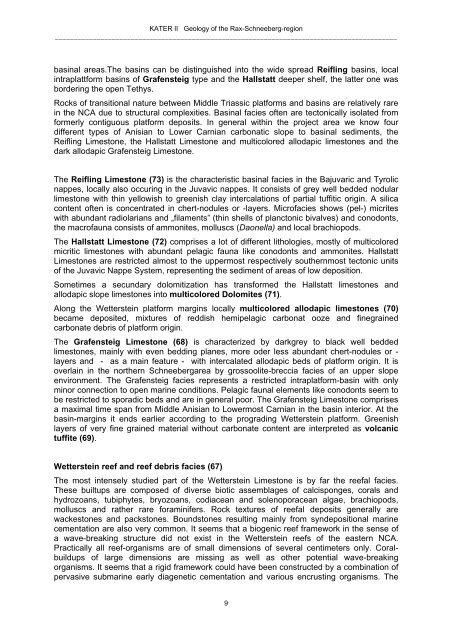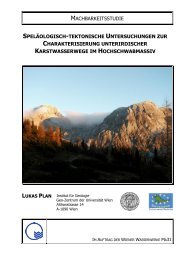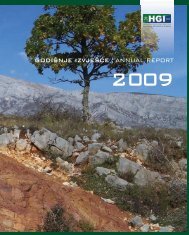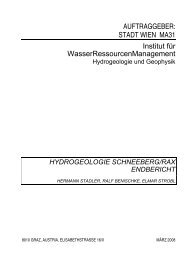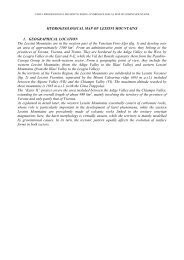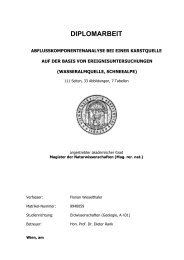Explanatory notes to the digital geological map of the Rax ... - KATER
Explanatory notes to the digital geological map of the Rax ... - KATER
Explanatory notes to the digital geological map of the Rax ... - KATER
You also want an ePaper? Increase the reach of your titles
YUMPU automatically turns print PDFs into web optimized ePapers that Google loves.
<strong>KATER</strong> II Geology <strong>of</strong> <strong>the</strong> <strong>Rax</strong>-Schneeberg-region<br />
__________________________________________________________________________________________<br />
basinal areas.The basins can be distinguished in<strong>to</strong> <strong>the</strong> wide spread Reifling basins, local<br />
intraplattform basins <strong>of</strong> Grafensteig type and <strong>the</strong> Hallstatt deeper shelf, <strong>the</strong> latter one was<br />
bordering <strong>the</strong> open Tethys.<br />
Rocks <strong>of</strong> transitional nature between Middle Triassic platforms and basins are relatively rare<br />
in <strong>the</strong> NCA due <strong>to</strong> structural complexities. Basinal facies <strong>of</strong>ten are tec<strong>to</strong>nically isolated from<br />
formerly contiguous platform deposits. In general within <strong>the</strong> project area we know four<br />
different types <strong>of</strong> Anisian <strong>to</strong> Lower Carnian carbonatic slope <strong>to</strong> basinal sediments, <strong>the</strong><br />
Reifling Limes<strong>to</strong>ne, <strong>the</strong> Hallstatt Limes<strong>to</strong>ne and multicolored allodapic limes<strong>to</strong>nes and <strong>the</strong><br />
dark allodapic Grafensteig Limes<strong>to</strong>ne.<br />
The Reifling Limes<strong>to</strong>ne (73) is <strong>the</strong> characteristic basinal facies in <strong>the</strong> Bajuvaric and Tyrolic<br />
nappes, locally also occuring in <strong>the</strong> Juvavic nappes. It consists <strong>of</strong> grey well bedded nodular<br />
limes<strong>to</strong>ne with thin yellowish <strong>to</strong> greenish clay intercalations <strong>of</strong> partial tuffitic origin. A silica<br />
content <strong>of</strong>ten is concentrated in chert-nodules or -layers. Micr<strong>of</strong>acies shows (pel-) micrites<br />
with abundant radiolarians and „filaments” (thin shells <strong>of</strong> planc<strong>to</strong>nic bivalves) and conodonts,<br />
<strong>the</strong> macr<strong>of</strong>auna consists <strong>of</strong> ammonites, molluscs (Daonella) and local brachiopods.<br />
The Hallstatt Limes<strong>to</strong>ne (72) comprises a lot <strong>of</strong> different lithologies, mostly <strong>of</strong> multicolored<br />
micritic limes<strong>to</strong>nes with abundant pelagic fauna like conodonts and ammonites. Hallstatt<br />
Limes<strong>to</strong>nes are restricted almost <strong>to</strong> <strong>the</strong> uppermost respectively sou<strong>the</strong>rnmost tec<strong>to</strong>nic units<br />
<strong>of</strong> <strong>the</strong> Juvavic Nappe System, representing <strong>the</strong> sediment <strong>of</strong> areas <strong>of</strong> low deposition.<br />
Sometimes a secundary dolomitization has transformed <strong>the</strong> Hallstatt limes<strong>to</strong>nes and<br />
allodapic slope limes<strong>to</strong>nes in<strong>to</strong> multicolored Dolomites (71).<br />
Along <strong>the</strong> Wetterstein platform margins locally multicolored allodapic limes<strong>to</strong>nes (70)<br />
became deposited, mixtures <strong>of</strong> reddish hemipelagic carbonat ooze and finegrained<br />
carbonate debris <strong>of</strong> platform origin.<br />
The Grafensteig Limes<strong>to</strong>ne (68) is characterized by darkgrey <strong>to</strong> black well bedded<br />
limes<strong>to</strong>nes, mainly with even bedding planes, more oder less abundant chert-nodules or -<br />
layers and - as a main feature - with intercalated allodapic beds <strong>of</strong> platform origin. It is<br />
overlain in <strong>the</strong> nor<strong>the</strong>rn Schneebergarea by grossoolite-breccia facies <strong>of</strong> an upper slope<br />
environment. The Grafensteig facies represents a restricted intraplatform-basin with only<br />
minor connection <strong>to</strong> open marine conditions. Pelagic faunal elements like conodonts seem <strong>to</strong><br />
be restricted <strong>to</strong> sporadic beds and are in general poor. The Grafensteig Limes<strong>to</strong>ne comprises<br />
a maximal time span from Middle Anisian <strong>to</strong> Lowermost Carnian in <strong>the</strong> basin interior. At <strong>the</strong><br />
basin-margins it ends earlier according <strong>to</strong> <strong>the</strong> prograding Wetterstein platform. Greenish<br />
layers <strong>of</strong> very fine grained material without carbonate content are interpreted as volcanic<br />
tuffite (69).<br />
Wetterstein reef and reef debris facies (67)<br />
The most intensely studied part <strong>of</strong> <strong>the</strong> Wetterstein Limes<strong>to</strong>ne is by far <strong>the</strong> reefal facies.<br />
These builtups are composed <strong>of</strong> diverse biotic assemblages <strong>of</strong> calcisponges, corals and<br />
hydrozoans, tubiphytes, bryozoans, codiacean and solenoporacean algae, brachiopods,<br />
molluscs and ra<strong>the</strong>r rare foraminifers. Rock textures <strong>of</strong> reefal deposits generally are<br />
wackes<strong>to</strong>nes and packs<strong>to</strong>nes. Bounds<strong>to</strong>nes resulting mainly from syndepositional marine<br />
cementation are also very common. It seems that a biogenic reef framework in <strong>the</strong> sense <strong>of</strong><br />
a wave-breaking structure did not exist in <strong>the</strong> Wetterstein reefs <strong>of</strong> <strong>the</strong> eastern NCA.<br />
Practically all reef-organisms are <strong>of</strong> small dimensions <strong>of</strong> several centimeters only. Coralbuildups<br />
<strong>of</strong> large dimensions are missing as well as o<strong>the</strong>r potential wave-breaking<br />
organisms. It seems that a rigid framework could have been constructed by a combination <strong>of</strong><br />
pervasive submarine early diagenetic cementation and various encrusting organisms. The<br />
9


